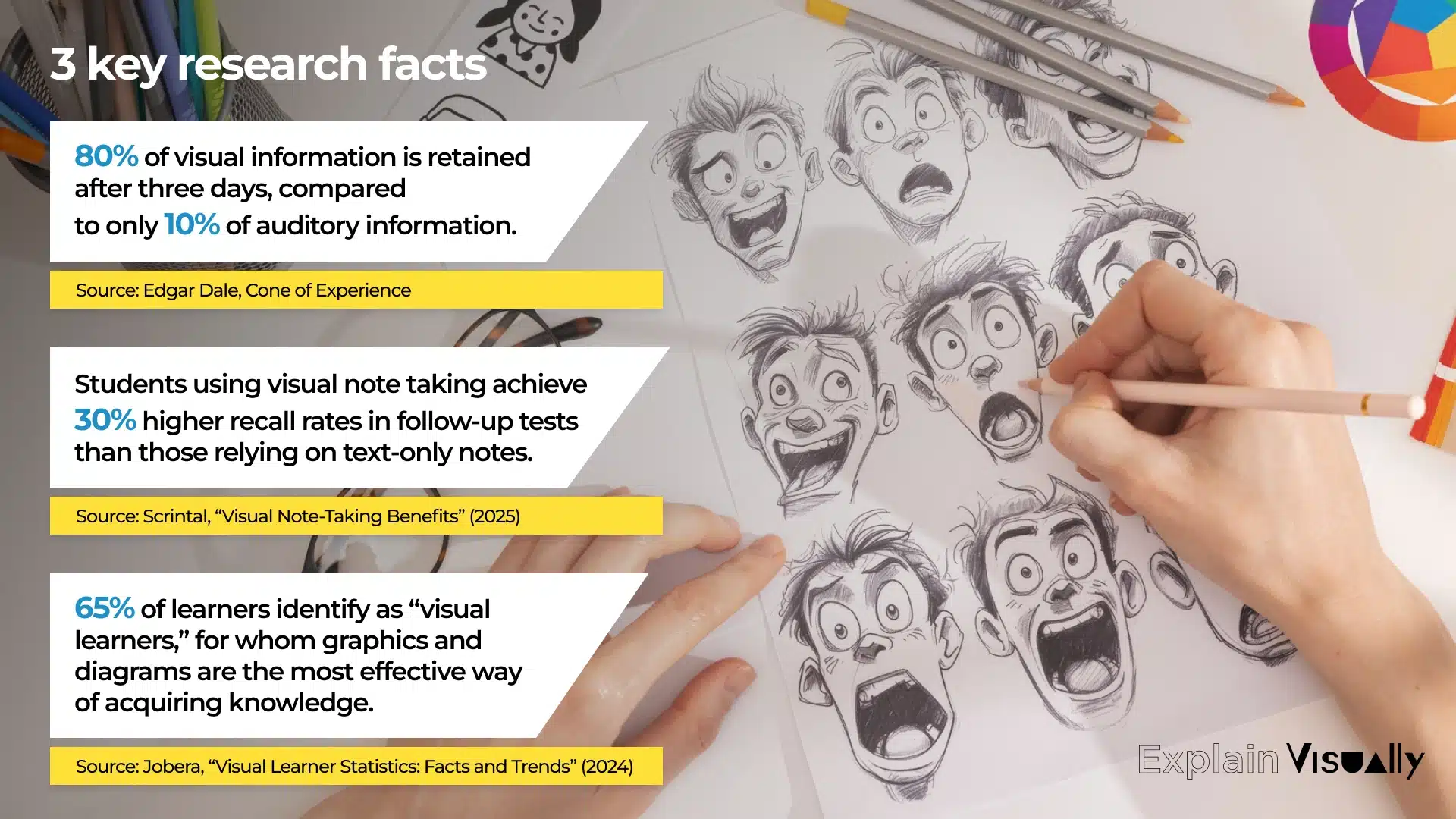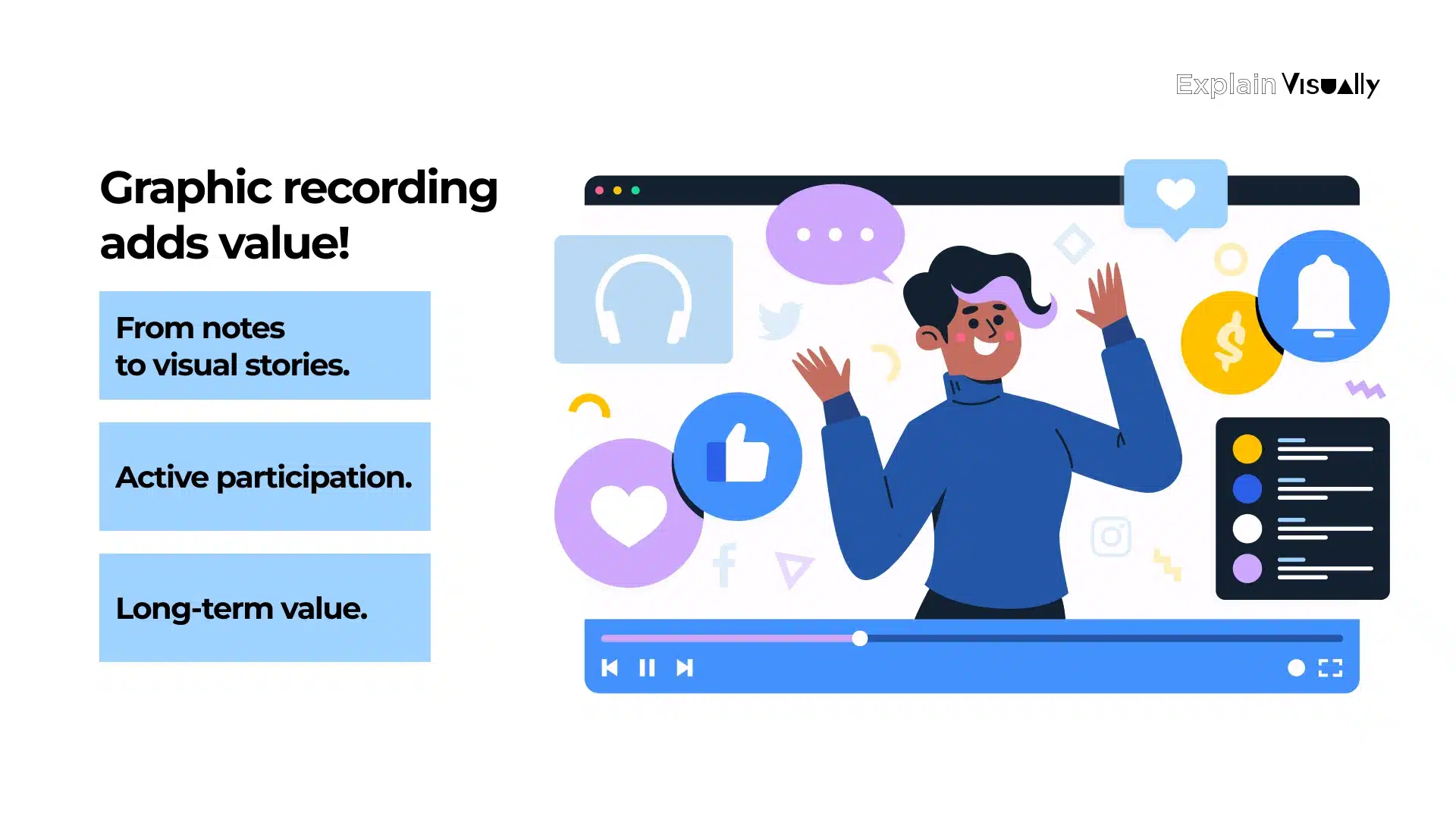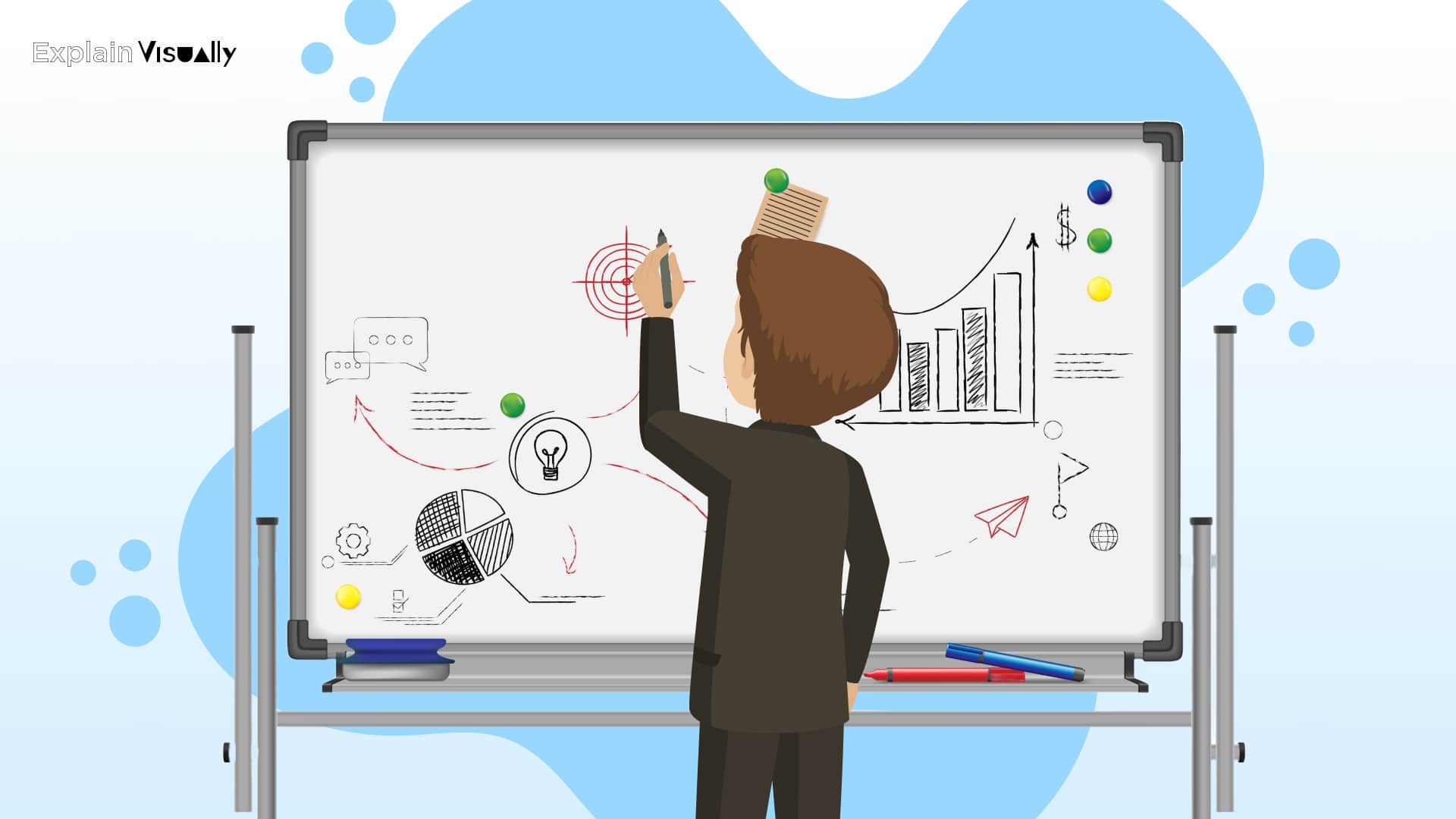Graphic recording isn’t new to you. You’ve heard about it many times. You’ve even had live-created educational materials in your hands. But despite all this, you still haven’t made the jump to using this tool in your work? Time to change that! Graphic recording in education is no longer a trend – it’s a proven method that transforms passive learning into active, lasting engagement.
First, here are the facts that should encourage you to read further:
Students remember up to 80% of what they see compared to only 10% of what they hear.[1]
Studies confirm what many educators already suspected. Graphic recording works because it taps into how our brains naturally process and store information. When someone does graphic recording, they’re watching ideas unfold in real time. It’s different from traditional passive note-taking. This approach creates dynamic visual documentation. The benefits continue for students, teachers, and educational organizations long after everyone has gone home.
The question is: why wouldn’t you use this tool’s potential too? Educational sessions aren’t just about attendance and passive listening. It’s about engaging participants, motivating them, and most of all…
LONG-TERM IMPACT.
Have you ever heard of graphic recording? It’s not the same anymore! See what’s changed!
Does the work of a graphic recorder still conjure an image of a silent person, almost invisible in the corner, jotting down the most important meeting points? The organiser then photocopies these notes and distributes them to participants afterward, hoping they’ll eagerly (and gratefully 😄) refer back to them in the comfort of their homes. They might, or they might not.
It all comes down to whether they felt like a valued, indeed indispensable, part of what appeared on the page. And that is precisely the difference between the past and the present: the genuine sense of co-creation and the invitation to include the graphic recorder as a temporary member of your team. Graphic recording in education captures this shift perfectly, turning students into true co-creators of the learning process.
But remember!
A good graphic recording isn’t about putting on a spectacular show. Far from it. It becomes part of the meeting, a second set of ears.
Modern graphic recording combines:
- a shared commitment to co-creating the visual narrative, fostering a sense of ownership and belonging within the project;
- the feeling of being an integral part of the learning journey;
- deep listening;
- live synthesis;
- intentional visualization.
This approach offers learning support that far surpasses simple drawing. It captures the heart of educational dialogue (both words and visuals) and turns it into dynamic visual stories as discussions unfold.
Modern graphic recorders move effortlessly between paper-and-marker setups and digital tools like tablets and interactive boards. They immerse themselves in discussion, record key points on the spot, and convert them into visual documentation. This process brings students together around a shared understanding and creates reference materials for continued learning.
The technique adapts easily to any format. In-person workshops leverage bold, large-format visuals to focus group attention, while virtual and hybrid environments harness digital capabilities for effortless sharing and LMS integration.
In every context, graphic recording’s key advantage is making complex concepts accessible and memorable through visualization.

Do you like to “dig into” history as much as we do? We have a great reading recommendation for you. You absolutely must read the journal article “The Beginnings of Graphic Recording” by Hebbel E. Hoff and L. A. Geddes.
Graphic recording in education with Explain Visually
Welcome to Explain Visually, where you’ll find outstanding graphic recorders. Visual summaries that make complex educational content easy to understand and remember? That’s exactly what we do! We combine insights from educational psychology with our own visualization techniques, honed in collaboration with schools, businesses, and NGOs.

Our visuals are never just decoration or an optional extra!
They’re designed around your teaching objectives and expectations. We always deliver on our joint plan, and our collaboration is seamless. We’ve never seen disappointment on our clients’ faces and that’s the best proof that we’re doing it right!
We start by analyzing your content and target audience, then craft each element to reinforce key concepts. The result is a cohesive set of visual tools that support both teaching and learning.
Our services cover:
- Paper-based graphic recordings in large formats for classroom walls and conference halls.
- Digital graphic recording on tablets and interactive smartboards for instant sharing.
- Virtual event graphic summaries that keep dispersed audiences engaged.
- Narrative-driven visuals that connect topics into a coherent story.
Our full range of services covers everything you need to bring learning content to life. We offer a variety of animation styles:
Digital graphic recording:

Step-by-step whiteboard animation:
Why graphic recording? These benefits are sure to convince you
Countless studies confirm that visual note-taking leads to real gains in learning (no matter the environment). Learners using visuals outperform their peers in both immediate understanding and long-term recall compared to plain text notes.
Do numbers speak to you? These are sure to make an impression:

We’ve covered these benefits at length in our in-depth blog posts (by the way, be sure to check out our entireblog). We could talk about them forever, because anything truly valuable deserves to be highlighted. So let’s be frank:
What’s in it for you as the organiser (whether you’re a teacher, lecturer or trainer) and for your audience, namely the students?

At the heart of visual learning lies superior memory retention
Research shows that students remember noticeably more when information is presented visually rather than as plain text. Why is this? Visual elements strengthen learning by creating multiple neural pathways, so students find it easier to pull up the right details when they need them.
Better engagement solves a key issue in education
Visual note-taking turns students into active participants, not just passive listeners. Seeing their ideas drawn out in real time makes learners feel understood and respected. That, in turn, boosts their willingness to join discussions and work together.
Organization is effortless with visual methods
Organization is effortless with visual methods. Similar points appear side by side, so reviewing feels faster and more complete. Students spend less time thumbing through notes and more time exploring how ideas interrelate.
Using visuals expands access to education
They bridge language barriers, aid students with different learning needs, and cater to a variety of learning styles. When you use clear visual metaphors and organized diagrams, even the most complex topics feel more approachable.
Visual note-taking sharpens critical thinking
What’s the deal with emphasising “real-time” learning? Why is it so important? Is it just about saving time, or are there deeper benefits? Of course there are! Students must decide which points matter most, reorganise ideas into visuals, and draw links between them. This hands-on analysis deepens their understanding and ensures the material sticks with them.
Looking for other ways to learn and remember effectively? Read also: Animated Instructions to Simplify Your Learning Experience
Don’t confuse these two terms! The role of a graphic facilitator and graphic recording
A graphic recorder focuses on capturing spoken content in real time, transforming presentations or discussions into visual notes that document key ideas and themes. Their primary responsibility is to listen deeply, synthesize information on the fly, and produce clear, engaging visuals that participants can reference later.
And what about graphic facilitation skills?
A graphic facilitator, by contrast, plays a more active role in guiding group processes. Beyond visual documentation, they use their skills in graphic facilitation to structure workshops, pose visual prompts, and encourage interaction. They help participants explore ideas, reach consensus, and solve problems by integrating visuals directly into meeting dynamics.
In short, a graphic recorder records what’s said; a graphic facilitator shapes what happens. Not entirely sure which solutions will suit your project best? Remember: the only foolish question is the one not asked😅. Get in touch with us, and we’ll be sure to suggest the perfect collaboration option for you. Let’s talk.
Graphic recording in practice
Ready to peek behind the curtain?
Before pens hit paper (or fingers tap screens), our team dives into a rapid-fire prep session. We map out your session’s core goals, flag the “must-capture” moments, and even test sightlines to ensure every visual will pop whether on a 2×3 m mural or a remote-share screen. This upfront planning ensures we’re crafting an experience that grabs attention from the first stroke.

When the live session begins, we hit the ground running. We listen closely, extract core ideas, and sketch visuals (frameworks, symbols, metaphors) in real time. If a point needs extra clarity, we pause to confirm with you, keeping our imagery and your message aligned throughout.
Once the session wraps, we shift into high-speed post-production. We digitize each sketch, polish details, and layer in color for lasting appeal. Graphic recording in education makes this step especially valuable, as it turns fleeting discussions into clear, reusable learning tools. Then we deliver your visuals as slide decks, animations, or print-ready posters. So everyone can revisit the insights anytime. That’s how raw content becomes dynamic learning resources.
You absolutely must see how we work before you get in touch! Check out our YouTube channel to see what it looks like in practice. See: How does the graphic recording process work?
Graphic recording adds value!
Still undecided? You might wonder: how exactly does graphic recording transform an educational session and its outcomes? Let’s break down what graphic recording really brings to your educational event.

First up: clarity.
Instead of half-forgotten notes, participants walk away with clear images they can act on.
Then comes the lift in engagement.
Watching ideas drawn live ignites excitement–people lean forward, eager to see their thoughts captured. Graphic recording in education makes this moment even more impactful, as learners instantly see their contributions take shape on the page. That energy fuels richer discussions and new ideas. Those shared visuals become the group’s collaborative map, moving everyone from passive observers to engaged creators.
Lastly (but not last), think lasting value.
Those custom visuals become evergreen assets:
- reference sheets for future sessions,
- compelling marketing pieces,
- dynamic recap videos.
This is more than an added perk. It’s an investment in clarity, retention, and reach well beyond the session itself.
Read also: Understanding the role of graphic recording in effective communication.
Best practices for graphic recording in education
Let’s wrap up by looking at best practices and the mindset. To make graphic recording truly effective, you have to follow tried-and-true methods that maximise learning and sidestep common traps.

Smart integration ensures graphic recording stays a tool for learning, not a side show. Good graphic recording supports the teaching goals without turning into a distracting show. Skilled recorders stay in the background while delivering clear, engaging visual summaries.
Accessibility considerations make sure our visuals include everyone, no matter their background or abilities. How do we take care of this issue?We choose clear, culturally aware images that work across languages. We also use high-contrast colors and legible text sizes so anyone can see and understand the content from any distance or angle.
Documentation standards. Effective documentation relies on structured templates paired with flexible frameworks. These tools should enforce coherence in layout while permitting spontaneous annotations and innovative connections between concepts.
Optimal environment setup. To set up optimally, think visibility and engagement. In person, position the visual surface so everyone has a clear view and use soft, even lighting to avoid reflections. Online, pick a screen-share platform offering high-quality resolution and minimal lag, ensuring participants see each sketch as it happens.
Creating professional rapport is fundamental. We wrote about this at the very beginning. A graphic recorder is a co-creator of the learning experience, not just a witness. That’s why you should establish how you’ll communicate with the facilitator and participants before the session.
Ready to transform your educational approach with graphic recording?
Explain Visually creates visual learning experiences that grab students’ attention and boost understanding at every educational level. We know how to blend visual thinking with what actually works in education, so your investment pays off with real improvements in how students learn.

If you’re curious about the kinds of graphic recording projects we undertake and want to explore how we can support your work, get in touch with us.
We usually reply to emails on the same day.
I’d like to learn more about Graphic Recording in Education.
𝐄𝐱𝐩𝐥𝐚𝐢𝐧 𝐕𝐢𝐬𝐮𝐚𝐥𝐥𝐲 – 𝐁𝟐𝐁 𝐚𝐧𝐢𝐦𝐚𝐭𝐢𝐨𝐧 𝐬𝐭𝐮𝐝𝐢𝐨:
• We create whiteboard animations for businesses
• We create corporate explainer videos
• We create visual storytelling for companies
Source:
[1] Lester, P. M. (2006) – “Syntactic Theory of Visual Communication”


